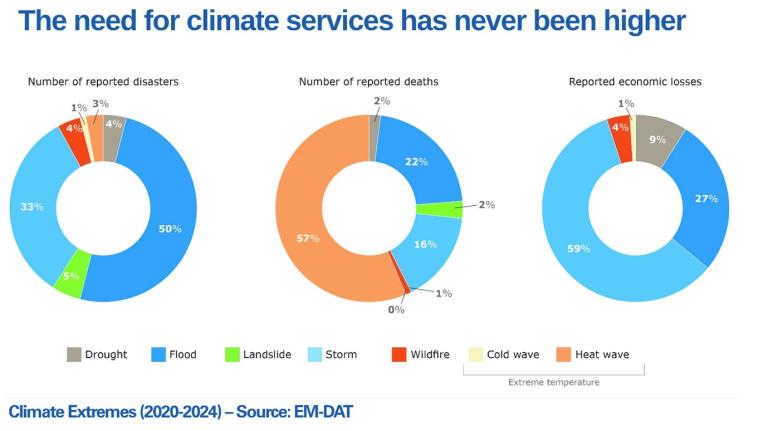WMO: climate services support climate action
As climate change impacts intensify, the need for climate services to support mitigation, adaptation and increase resilience has never been higher. In the past five years, there has been progress in provision of this climate information for decision-making, but big gaps remain and investment lags far behind needs, according to a new multi-agency flagship report produced by the World Meteorological Organization (WMO).

The State of Climate Services report says that in 2024, one third of National Meteorological and Hydrological Services (NMHSs) provide climate services at an ‘essential’ level, and nearly one third at an ‘advanced’ or `full’ level. It says that countries in Asia and Africa, in particular, have made strides in boosting their capacity thanks to targeted adaptation funding.
“On our journey towards sustainable development, we need to do more to turn climate science and climate information into actionable services, to make climate services more accessible and to use them more effectively,” says WMO Secretary-General Celeste Saulo.
“In the face of unprecedented environmental challenges, the development, delivery, and use of climate information to enable climate action has never been more crucial,” she says.
2023 was the warmest year on record to date, with the unprecedented warmth continuing into 2024. Many climate extremes are becoming more frequent and intense. While weather and climate-related reported deaths are decreasing over time due to better early warnings and disaster risk management, economic losses are increasing.
In the period from 2020 to mid- 2024, floods remained the most frequently reported disaster. However, heat-related hazards became the leading cause of deaths, accounting for 57% of the total reported weather, water, and climate related-deaths globally. Storms resulted in the greatest economic losses, contributing to 59% of the total, according to data from the International Disaster Database EM-DAT cited in the report.

Of the US$63 billion being spent on climate adaptation, nearly a third goes towards climate-informed investments, with a small portion (estimated at about US$4 to 5 billion) of that explicitly supporting climate services and early warning activities, according to the report.
But despite an overall increase, the report notes that the continued investment is not necessarily translating into support for building the capacities of National Meteorological and Hydrological Services, which are essential organisations for supporting climate action at the national and local level through provision of climate information services. Latin America and Caribbean, for instance, face a growing need for early warning services to deal with hazards such as forest fires and droughts.
“We need to make the necessary investments for a sustainable future. The cost of no action is several times higher than the cost of action. This is why it is essential to increase support for NMHSs for collecting better knowledge of the Earth’s system and its changes, delivering fit-for-purpose climate services to support decision making, and developing early warning systems to protect communities from increasing natural hazards,” says Celeste Saulo.
WMO has issued annual reports on the state of climate services for the past five years. This is in response to a request from the UN Framework Convention on Climate Change Conference of the Parties (COP) for more information on adaptation needs and to help identify steps needed to address climate service gaps and needs, to inform more effective investment. All climate action investments need to be climate informed so that they are forward looking – the past is no longer indicative of the future.
The latest edition of the report explores the current state of play and also documents the progress that has been made in the last five years. It includes analyses and stories to explain how specific countries, including Seychelles, Mauritius, Laos, and Ireland, have succeeded in developing and using climate services to deliver a range of socioeconomic benefits and to advance climate action.
The report is based on contributions from 38 partners including major climate finance institutions, such as the Green Climate Fund, Adaptation Fund and the Global Environment Facility that are founding partners of the report series, and the UNFCCC Secretariat. The UN Office for Disaster Risk Reduction worked closely with WMO on the Investment section of this year's edition.
WMO will present the State of Climate Services 2024 report at COP29 in Baku, Azerbaijan. It complements the UN Environment Programme’s Adaptation Gap report, also published on 7 November.
Note for editors
The Climate Services Dashboard offers a comprehensive view of global efforts in climate services, providing critical insights into policy, capacity, and investment.










